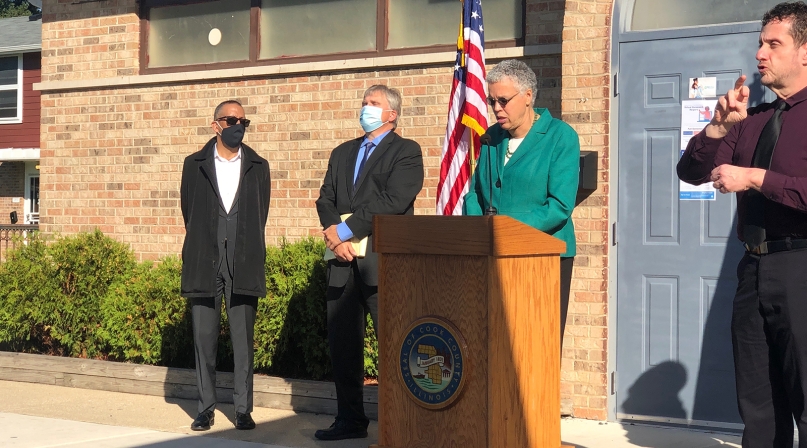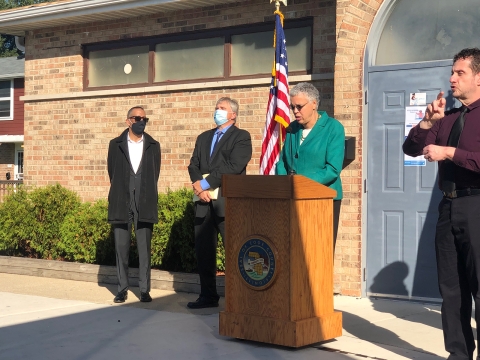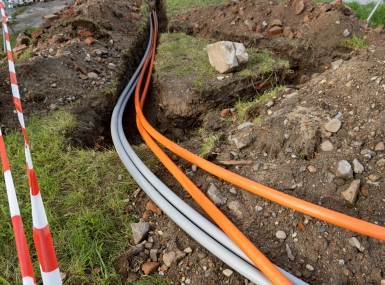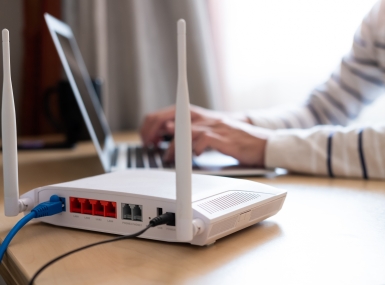Pandemic changes dynamic around broadband

Pamela Carter was excited to have recently been named to the FCC’s Intergovernmental Advisory Committee, where she is one of three county government representatives.
Except her own internet service at home is so poor, she has to drive to the Augusta County, Va. office building, where she is a county supervisor, to log into hours-long video meetings. And she knows that in Virginia’s second-largest county by area, she is far from the only person with problems like that.
Learn More
“I get emails from residents every day complaining about the lack of broadband,” she said. “I hate telling them ‘we’re working on it,’ because it sounds like we’re not doing anything, but it’s expensive and we don’t have a lot of options right now.”
Augusta County’s broadband service has been a growing concern for years, with half of its residents reporting on a survey that they don’t have adequate service, but it picked up widespread attention, as it has in counties across the country, this spring when the COVID-19 pandemic sent workers and students alike home and online, digitally elbowing each other for bandwidth and bringing the digital divide into sharp relief.
A rapidly growing number of people learned what many already knew — the nation’s information technology infrastructure was insufficient. In rural swaths and urban pockets, residents remain disconnected from the types of internet speeds necessary to run businesses, take classes, operate machinery and practice medicine.
Though many counties are deploying internet hotspots for residents to come and use to bridge gaps in service, many are funded by CARES Act money that will expire after Dec. 30. The cost of building out the fiber to extend broadband service often leaves large rural counties like Augusta reliant on state and federal grants, including from the Virginia Telecommunication Initiative.
The Federal Communications Commission defines minimum download speed as 25 Mbps for student and telecommuting needs. The unreliability in the FCC’s own broadband coverage maps, however, prompted NACo to develop its TestIT app to provide real data on connectivity.
Education
Although much of the focus on broadband service needs centers on large rural counties, even in dense urban counties, broadband service can vary from block to block, and the number of users can be overwhelming.
When the majority of schools shut down in March, it was not as easy for many students as simply turning on a computer and joining a virtual classroom with a click of the mouse.
An analysis of census data revealed 3 million students lack home internet and an estimated 17 percent of students do not have access to computers, according to a report last year by the Associated Press.
In Cook County, Ill. the pandemic emphasized the county’s own broadband challenges.
County Board President Toni Preckwinkle said the county’s Bureau of Economic Development and Council on Digital Equity found a quarter of county residents lack high speed internet. Additionally, 17 percent of Black and Latinx families throughout the county lack computers.
To help bridge this digital divide, Cook County, Ill. recently launched two digital inclusion initiatives to provide students with the resources needed to complete e-learning.
The first initiative involved a partnership with the Housing Authority of Cook County (HACC) and Comcast through the Internet Essentials Partnership Program which provided no-cost broadband internet to housing authority households with school-age children.
The program is being offered to nearly 14,000 children residing in over 6,500 households throughout Cook County.
More than 1,100 HACC residents with children took advantage of the program. HACC covered the cost for the next 10 months, through the 2020 to 2021 school year.
After the partnership between HACC and Comcast helped fill the need for broadband access, it became apparent that many families also needed the equipment to access the internet.
This led to the county’s second initiative to provide laptops for all school-age HACC students who needed e-learning devices. HACC pre-ordered 900 laptops for around $300 per laptop.
“We provided the young people in the Housing Authority with free laptops that are theirs, period,” Preckwinkle said. “They are not loans. They’re theirs so that they can continue to do their work remotely as their school district requires.”
Many families who signed up for the Internet Essentials partnership indicated that local school districts were not issuing laptops or had run out of devices, leaving children sharing a device within their family.
Preckwinkle added that some school districts provided laptops as long as there was e-learning, but as soon as some schools resumed in-person classes, students had to return the devices.
The laptop initiative helped fill these gaps allowing children to fully participate in any virtual learning and have the time to complete assignments.
Both the laptop program and Internet Essentials partnership are funded by CARES Act dollars.
While the county has been making efforts in the past to provide broadband access by investing in fiber optic cable to connect more residents, Preckwinkle said the pandemic emphasized the digital access inequity.
“We live in a country where there’s tremendous inequity and a lot of it is race based and the extent to which we can help level the playing field by providing people first with access to internet and second with the tools they need to access the internet, that’s all to the good,” she said.
Health
Back in Augusta County, Va., Carter teaches at Mary Baldwin College, and she has been recording lectures, not just so her nursing students can watch them at their convenience, but to ensure the kind of quality that she can’t vouch for on her side or her students. In addition to being a large county, geographically, its topography, particularly in the western underserved region, is full of high, narrow mountain ridges making both cell service and internet services unreliable.
“That’s the opposite of telehealth,” she said. “When you’re doing a telehealth visit, you want to be able to connect visually with your doctor, but in most parts of our county, the video freezes or you can’t get good eye contact with the doctor and it defeats the whole purpose of video contact.”
As concerns about crowding inside buildings during the pandemic has driven strict rules about occupancy, a desire to limit the number of vulnerable people in waiting rooms has driven much of the health care field to remote visits.
“I haven’t had a telehealth visit from home that went smoothly,” Carter said. “My experience is shared among a lot of our residents, and many of them would really benefit from an advance like this because they’d have to travel really far to see a doctor otherwise.
“It puts people living here at a disadvantage.”
Counties that have the internet capacity to successfully use telehealth have seen boosts in their efficiency, particularly with regard to mental health support during the pandemic.
Sevet Johnson, behavioral health director for Ventura County, Calif., said that not having to drive among clients has freed up time among her county’s clinicians and reduced the risk of traffic accidents en route to appointments.
Carter has been frustrated by the apparent ineligibility of using CARES Act money to build out broadband capacity, even if it’s done in the name of expanding access to telehealth, but she and the rest of the county’s broadband committee will continue pursuing grants to entice internet service providers to build out fiber and fielding more complaints from residents.
Carter hopes, however, that her work on the FCC advisory committee will offer educational opportunities to help her strategize a way forward for Augusta County.
“I’m hoping this will open doors to knowledge I don’t have now,” she said. “We’ll have to get creative with how we do this, but I have hope.”
Broadband Resources for Counties
The National Telecommunications and Information Administration at the Department of Commerce has created a searchable database of 50 federal broadband grants, loans and other resources.
“Consolidating these critical resources into a one-stop, easy-to-use resource provides an important tool in spurring efforts to expand our nation’s broadband infrastructure projects,” said Diane Rinaldo, acting assistant secretary for Communications and Information at NTIA.
The federal programs provide funding for state and local governments, schools, libraries, small businesses and other community groups interested in expanding broadband access. Applicants can search for programs by agency, program purpose and eligible recipients. The inventory includes well-known infrastructure efforts at the Department of Agriculture and the Federal Communications Commission.
For instance, the Commerce Department’s Economic Development Administration provides economic development grants that can be used to support broadband infrastructure projects, digital skills training and smart cities development. The agency’s FY2018 funding of $600 million was mainly targeted for weather-related disaster relief but also supported broadband projects.
Last year, U.S. Secretary of Commerce Wilbur Ross announced a $1 million grant to St. Joseph County, Ind., to expand high-speed broadband infrastructure in a project expected to create 230 jobs and spur $710 million in private investment.
Other programs in the NTIA inventory that recently made broadband grants include The Appalachian Regional Commission.
A $40,000 grant was awarded to the SEDA-Council of Governments, a public development organization serving 11 central Pennsylvania counties, for a feasibility study of broadband access in Northumberland, Union, Lycoming, and Clinton counties.
As the federal government works to fill the gaps in connectivity that persist despite significant investments, NTIA is developing a new mapping platform that paints a more precise picture of the current infrastructure and services that are available around the country. This will help policymakers make better decisions about how broadband funds should be allocated.
Sources include:
- Appalachian Regional Commission: ARC is a regional economic development agency that represents a partnership of federal, state and local governments. 202-884-7700.
- The Rural Health Care Program provides funding to eligible public or non-profit health care providers for broadband and telecommunications services necessary for the provision of health care. 202-418-7400.
- The Department of Education, Small Rural School Achievement Program provides financial assistance to address lack of personnel and resources needed to compete for federal grants. 202-401-0039.
Broadband CIO Forum set for Nov. 18
NACo will hold a CIO Forum titled “Innovation: Fast Forward – Broadband” Nov. 18 from 12 noon to 3 p.m. It is part of the NACo Tech Xchange CIO Forum Series. Presentations will be made by:
- Russ Elliott, director, Washington State Broadband Office, will share their efforts to address broadband in the state of Washington.
- Deana Perry, executive director, Broadband, Georgia Department of Community Affairs and Bill Price, strategist, Georgia Technology Authority, will share broadband efforts in Georgia.
- County presentation from Mike Culp, CGCIO, director of Information Technology for Albemarle County, Va. Culp is the Chief Administrative Officer for the Albemarle Broadband Authority, a member of both a regional broadband cooperative and the Governor’s Broadband Advisory Council
- Representatives from Comcast and Verizon will discuss various efforts and activities to improve broadband delivery to counties and citizens.

Attachments
Related News

Bureau of Land Management updates regulations for broadband infrastructure development on federal public lands
The BLM published a final rule to update regulations for developing and operating broadband infrastructure on public lands.

FCC takes critical steps to improve the 988 National Suicide Lifeline
On March 21, bipartisan congressional leaders and FCC Chairwoman Jessica Rosenworcel announced steps to improve the 988 National Suicide Lifeline. This announcement marks major progress on the nation’s crisis response, a priority for counties and a key policy pillar of the NACo Commission on Mental Health and Wellbeing.


